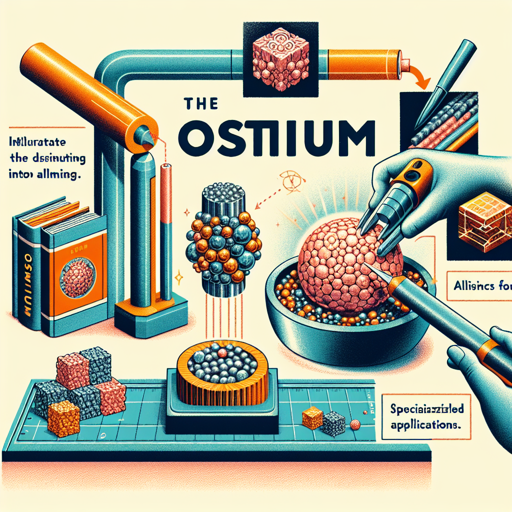Unveiling the Mysteries of Osmium in Alloys
A deep dive into the world of osmium and its role in alloy creation.

Introduction
Osmium, with its silvery-blue hue and incredible density, is one of the rarest elements found in the Earth’s crust. This precious metal has fascinated scientists and geologists alike for centuries. However, its real magic lies in its ability to blend with other metals to form alloys with remarkable properties.
Osmium: A Brief Overview
Osmium belongs to the platinum group metals (PGMs), a collection of six elements known for their exceptional resistance to heat, wear, and chemical reactions. Osmium itself is the densest naturally occurring element, with a density of 22.59 g/cm³. This paves the way for its use in high-density applications.
The metal is usually obtained as a by-product of nickel and copper mining. Its name derives from the Greek word “osme,” meaning “a smell,” because of the pungent odor of its volatile oxide.
The Role of Osmium in Alloys
Osmium’s high melting point and hardness make it a popular choice for alloy production. When combined with other metals, it enhances their strength, durability, and resistance to corrosion and wear.
Osmium is often alloyed with platinum and iridium to create extremely hard materials. These alloys find their application in high-wear environments such as electrical contacts, fountain pen nibs, and record player needles.
Another common use is in the creation of osmiridium, an alloy of osmium and iridium. This alloy is one of the hardest known substances and is used in applications where extreme durability is required.
“Alloys are like a superpower for metals. When osmium becomes part of an alloy, it brings its own set of unique capabilities, enhancing the overall strength and durability of the new material.” -Anonymous
Osmium Alloys: Key Comparisons
| Alloy | Composition | Key Properties | Common Applications |
|---|---|---|---|
| Osmiridium | Osmium and Iridium | Extremely hard, high melting point | High-durability applications |
| Pt-Os Alloy | Platinum and Osmium | High strength and corrosion resistance | Electrical contacts, fountain pen nibs |
Osmium Data from Royal Society of Chemistry
Conclusion
Unquestionably, osmium’s role in the creation of alloys is critical. Its extraordinary properties, such as density, durability, and resistance to wear and corrosion, make it a notable player in the world of metallurgy.
As we delve deeper into the properties and potentials of osmium, we discover a world of possibilities. From enhancing the durability of everyday objects like pens to contributing to the longevity of electrical contacts, osmium is a shining example of the wonders that lie beneath the Earth’s crust.
In the world of geology and earth sciences, osmium serves as a reminder of the incredible diversity and potential that our planet holds. It’s a testament to the beauty and complexity of the natural world, and a symbol of the endless possibilities that science and technology bring to our lives.